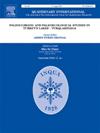近6000年珠江三角洲森林变迁与人类活动影响
IF 1.8
3区 地球科学
Q3 GEOGRAPHY, PHYSICAL
引用次数: 0
摘要
尽管在珠江三角洲(PRD)进行了大量的全新世研究,但对含有埋藏的古草木林的泥炭地的广泛、高分辨率调查仍然有限,阻碍了对那里植被演化和人类活动的全面了解。本研究以华南珠江三角洲内一个木材丰富的泥炭地为研究对象,利用磁化率、腐殖化、花粉和微炭等指标,揭示了过去6000 cal yr BP的环境和植被变化,捕捉了湿地形成、发展和消失的整个过程,以及植被从茂密森林到开放栖息地的转变。Glyptostrobus森林最初在公元前5000年左右形成,在公元前4100年至2800年之间繁盛。这一时期与珠江三角洲淡水湿地的扩张相吻合,强烈的季风驱动的淡水排放逐渐将海岸线向海推进,在珠江下游创造了大量的淡水湿地。这些新形成的湿地为雕蝽的繁衍提供了适宜的栖息地。同时,相对较强的亚洲夏季风维持了温暖湿润的气候,有利于草木林的繁荣。在3000 calyr BP之后,农业活动被确定为天然草木林退化和最终消失的主要驱动因素。我们的研究结果表明,最初的人类活动可以追溯到大约3500 calyr BP之前,在2800 calyr BP之前对当地植被产生了强烈的影响。该研究为了解该地区在三角洲演化和人类活动背景下的古生态系统变化提供了重要证据。本文章由计算机程序翻译,如有差异,请以英文原文为准。
Forest transformation and human impact in pearl river delta, south China, during the last 6000 cal yr BP
Despite numerous Holocene studies in the Pearl River Delta (PRD), extensive, high-resolution investigations of peatlands containing buried ancient Glyptostrobus forests remain limited, hindering a full understanding of vegetation evolution and human activity there. This study, conducted in a wood-rich peatland within PRD of South China, utilized magnetic susceptibility, humification, pollen, and microcharcoal indicators to elucidate substantial environmental and vegetational shifts over the last 6000 cal yr BP, capturing the entire process of wetland formation, development, and disappearance, as well as vegetation transitions from dense forests to open habitats. The Glyptostrobus forests initially developed around 5000 cal yr BP and thrived between 4100 and 2800 cal yr BP. This period coincided with the expansion of freshwater wetlands in the PRD, as strong monsoon-driven freshwater discharge progressively advanced the shoreline seaward, creating numerous freshwater wetlands in the lower reaches of the Pearl River. These newly formed wetlands provided suitable habitats for Glyptostrobus to thrive. Concurrently, the relatively strong Asian Summer Monsoon maintained a warm and wet climate, which was conducive to the prosperity of Glyptostrobus forests. Agricultural activities were identified as the main driver in the degradation and ultimate disappearance of natural Glyptostrobus forest after 3000 cal yr BP. Our findings suggesting primary human activities dating back to approximately 3500 cal yr BP ago, with intensive impacts on local vegetation by 2800 cal yr BP. This research provides crucial evidence for understanding palaeoecosystem changes in the context of deltaic evolution and human activities in this densely populated region.
求助全文
通过发布文献求助,成功后即可免费获取论文全文。
去求助
来源期刊

Quaternary International
地学-地球科学综合
CiteScore
5.60
自引率
4.50%
发文量
336
审稿时长
3 months
期刊介绍:
Quaternary International is the official journal of the International Union for Quaternary Research. The objectives are to publish a high quality scientific journal under the auspices of the premier Quaternary association that reflects the interdisciplinary nature of INQUA and records recent advances in Quaternary science that appeal to a wide audience.
This series will encompass all the full spectrum of the physical and natural sciences that are commonly employed in solving Quaternary problems. The policy is to publish peer refereed collected research papers from symposia, workshops and meetings sponsored by INQUA. In addition, other organizations may request publication of their collected works pertaining to the Quaternary.
 求助内容:
求助内容: 应助结果提醒方式:
应助结果提醒方式:


